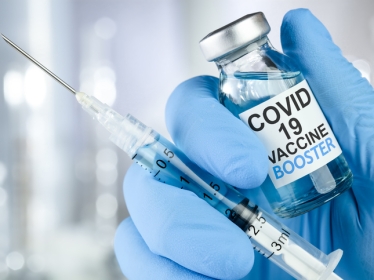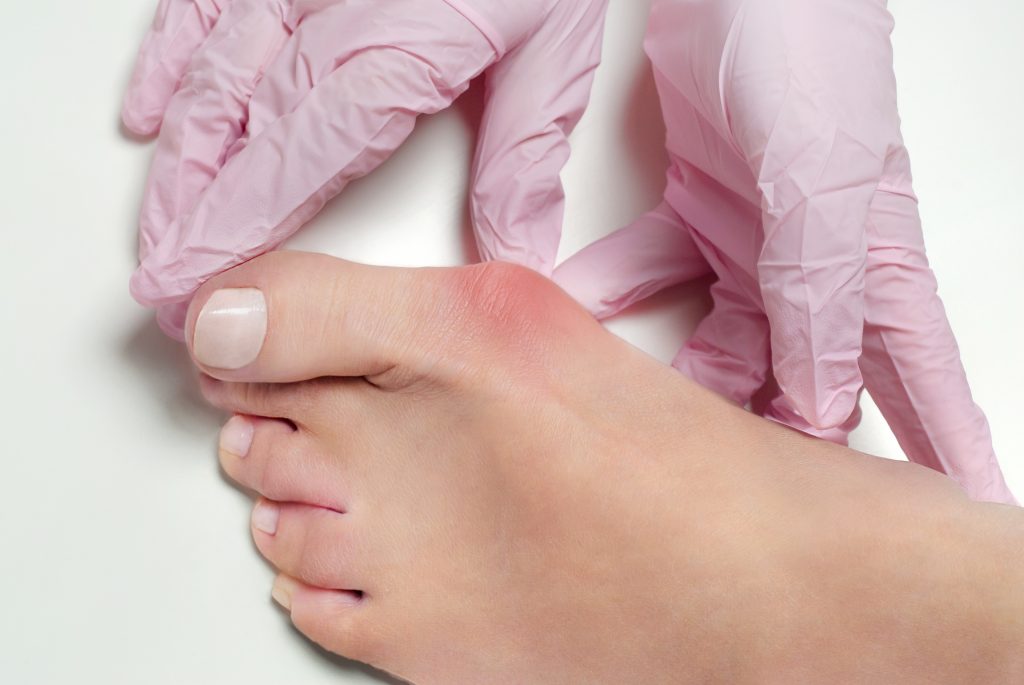 Hallux valgus, bunion in foot on white background
Hallux valgus, bunion in foot on white background
Bunions can be uncomfortable and cause difficulty walking. However, there are treatment options that are surgical or non-surgical, that will help to reduce or even eliminate the pain. One of these options is keyhole bunion surgery. Read more about this procedure and how it could be a better option for you.
What is a bunion?
A Bunion is a common deformity of the joint and tissues characterised by enlargement of the bone at the base of the toe. One in three women and one in ten men suffer from bunions.
What causes bunions?
It is often said that tight or high-heeled shoes can exacerbate the condition but they are often not the primary cause. There is certainly a genetic predisposition too. Bunion can get worse with time and cause pain and damage to the foot. Treatment in a timely fashion is therefore recommended.
What treatments are available?
Historically, many treatments and operations have been proposed for correction of bunion deformities. Some of these have been more popular than others but surgical correction in particular has had a reputation for ongoing pain, forefoot swelling and scar sensitivity. Modern keyhole surgery has overcome many of these problems and has lessened the risk of recurrence and complications.
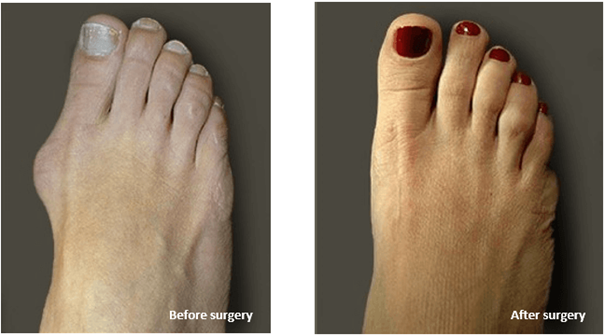
(Bunion; Before and after a keyhole bunion surgery)
What Is Keyhole Bunion Surgery?
MIS (Minimally Invasive ) or Keyhole Bunion surgery is a surgical technique to correct the bunion deformity just by using small key holes. The surgeon uses small tools to effectively remove bunion reducing the scars and recovery time. It is also goes by the name of MICA (Minimally Invasive Chevron-Akin Osteotomy ) . It involves very small cuts to access the bone and shift it to a correct position. Before considering bunion surgery, doctors suggest the patient wear comfortable wide toe box shoes. They also suggest using splints to reposition and straighten the toe. When these techniques do not work then surgery is offered. Surgery often resolves the problem completely by relieving the pain and realigning the bone.
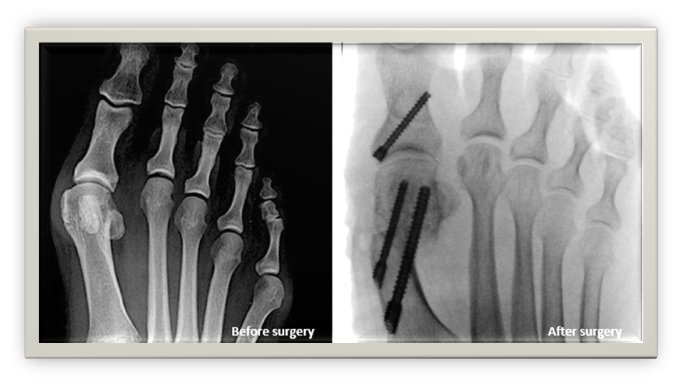
(X-Rays; Before and after a keyhole bunion surgery)
Advantages of Keyhole Bunion Surgery (MIS)
Following are the major advantages of a keyhole bunion surgery:
- Reduced bleeding
- Less damage to tissues and less scar sensitivity
- Less internal and external scarring (no long scars!!)
- Reduced joint stiffness
- Day case surgery
- Quicker recovery time
- Faster return to work and normal activities
- Possibly a better result
Surgical procedures usually depend upon the severity of the bunion, age, health, activity level, and connective tissues. Following factors may affect the choice of surgical procedure:
- Mild Bunion: In the case of a mild bunion, surgery involves the removal of an enlarged portion of bones and realigning the looser ligaments.
- Moderate Bunion: In the case of a moderate bunion, surgery involves the proper cut of the bone and fitting it back into place. The surrounding muscles may need to be repositioned; it depends upon the severity of the deformity.
- Severe Bunion: For a severe bunion, the surgeon cuts the bone, realigns it, and corrects the position of ligaments and muscles. Sometimes, even a fusion of the bone may be required.
When Might I Need Keyhole Bunion Surgery?
You may need to get a keyhole bunion surgery:
- If you have severe forefoot pain, especially over the bunion area, even when you wear flat comfortable, wide toe box, shoes
- If bunion enlargement, inflammation, and swelling doesn’t improve with medication
- Impingement onto your 2nd toe resulting in a ‘claw toe’ deformity. You need to get surgery before it gets worse. If you notice that bunion is causing trouble for other toes, this may be a time to consider surgery
How to Be Prepared for The Surgery?
Here is what you have to do before keyhole bunion surgery:
- You may be asked to fast for 6 hours before surgery
- You may receive a sedative; anaesthesia will get you relaxed
- When relaxed, you will get nerve block to make the foot numb
What Happens During the Surgery?
During the surgery, the following process takes place:
- The skin over the bunion is first cleaned with an antiseptic solution. If general anaesthesia is used, you will be asleep due to IV medicine.
- The surgeon will cut the bone with a small instrument ( burrs and rasps ), realign, and correct the deformity. X-rays will be taken to examine the condition.
- Lastly, the surgeon will close the opening using stitches and a bandage.
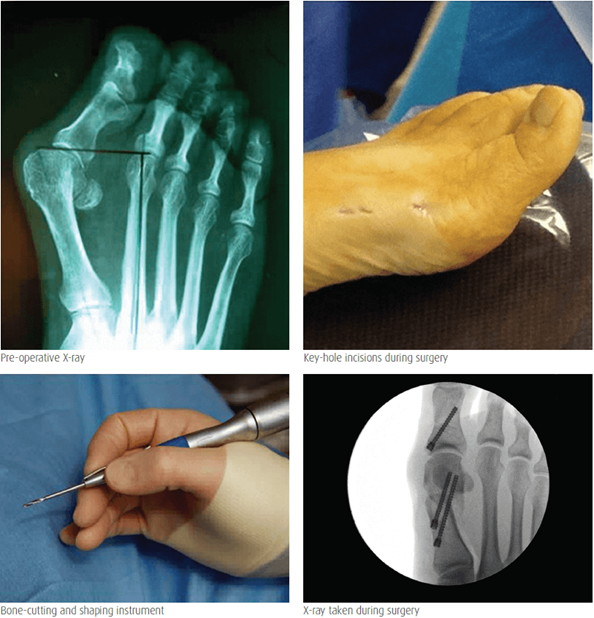
(Keyhole Bunion Surgical Procedure)
What happens After the Surgery?
Immediately after the surgery, an orthopaedic shoe will be placed on your foot. Once you get comfortable, you will be discharged from the hospital. You may feel swelling, redness, and pain in the surgical area. The swelling may increase if you keep your foot down. Putting too much pressure could be painful for the first week.
After the surgery, you have to follow a post-operative course which is as follows:
- First follow up at the hospital, with Dr Gowreeson takes place at least twice in the first 1-2 weeks, X-rays will be taken. The dressing will also be changed. You should make gentle movements and not take a higher dose of pain relievers. Driving should not be done during the first five weeks.
- 3rd follow up takes place during 3-6 week phase. You will be allowed to walk for gentle exercise. A toe spacer must be used all the time to lessen the risk of recurrence.
- During 6-7th week phase, you will be allowed to wear common shoes according to your foot condition. You can stop using the toe spacer.
- By the end of 3rd month, you are good to go, you can wear heels, run or walk and do whatever you want.
- Forefoot swelling may take 3 months to settle. Wearing proper shoes, elevating the foot when seated and regular physiotherapy will aid this process significantly.
Risks and Complications
No surgery is risk-free. Most of the keyhole bunion surgeries are successful but rarely, complications can occur. Following are some of the risks that can occur:
- Small risk of infection and blood clots ( 3-5% )
- The toe may appear too straight, causing a sense of overcorrection
- Pain and stiffness of the big toe ( 3-4% )
- Toe can become numb or over-sensitive ( much less risk than with open surgery )
- Risks of deformity recurrence ( 10% )
- However, 95% of the surgeries remain successful, therefore you need not fear the surgical procedure nor the rare complications.
Is Keyhole Bunion Surgery Better?
After all the discussion, the question remains: is it worth it?
In the opinion of Dr Gowreeson, the answer is yes, it is better and worth it.
Keyhole bunion surgery provides equivalent outcomes to open bunion surgery in the long term. It causes less pain, swelling, and stiffness because it does not include greater disruption of tissues. The surgery is performed by an experienced surgeon allowing many benefits over open surgery. It includes smaller cuts and scars, the smaller the scars the smaller the risk of infection. It allows just as early walking and more rapid recovery than historical bunion corrective surgeries. With all these benefits over open bunion surgery, keyhole or MIS has the edge over open surgery.



